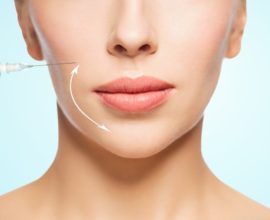Fillers / Injectables
10 Dermal Filler Facts
Dermal fillers are used to treat many skin imperfections including volume loss which is generally due to the aging process. Volume loss can cause deep facial creases and cause the skin to appear droopy or saggy. Dermal fillers can restore volume by plumping up the skin, smoothing creases, adding contour to the lips and filling shadowed curves. Other benefits of facial fillers include the fact that they can be used to improve the appearance of recessed or pitted scars. However, fillers weren’t always a spectacular means to facial rejuvenation. Wait until you hear some of these interesting facts about dermal fillers:

- Dermal fillers began as fat transplants and the first syringe was invented for that use in 1853. Not long after that, a Dr. Neuber made a new discovery. He was the first doctor to experiment with transferring fat from a patient’s arm in order to fill a facial defect in that year.
- In 1899, an Australian surgeon by the name of Dr. Robert Gersuny injected a patient with Vaseline to correct the absence of a testicle. The Vaseline was heated to a semi-liquid state and injected. The procedure was successful due to the fact that the Vaseline solidified upon cooling. This encouraged Dr. Gersuny to further his experiments of treating soft tissue defects.
- Paraffin was popular until the mid-1920’s for a broad range of treatments including filling wrinkles on the face, sunken cheeks, breast augmentation, nasal improvements and enlarging the penis. Paraffin had great initial results but caused severe secondary complications such as deformities due to the dispersion of the paraffin. While some patients had to live with the deformities caused by paraffin injections, others elected to have the treated area excised.
- Silicone injections were popular in the 1940’s and 1950’s. However, it had similar side effects including the formation of granulomas which traveled elsewhere in the body. Since silicone caused undesirable and dangerous complications; investigations began and silicone was quickly banned by the FDA. In 1992, a safer form of silicone was developed and approved for certain treatments.
- By the 1970’s, animal collagen had been researched and deemed to be safe to use on humans. Do you know which animal gave the best results? Moooo! In 1981, the FDA approved collagen derived from cows. It was introduced as collagen injections under the trade names Zyderm and Zyplast.
- Fat transfers were still being used throughout the years. In 1909, abdominal fat was used to correct the cheek and chin areas. In the early 20th century, fat transfers were used to treat hemifacial atrophy, AKA the shrinking of one side of the face, and breast defects. However, modern fat grafting didn’t begin to soar until the early 1980’s with the popularity of liposuction.
- In 2003, the FDA approved hyaluronic acid for use as dermal filler. In 2006, the FDA approved Restylane for use by doctors.
- Collagen and hyaluronic acid fillers are two types of dermal fillers which are naturally-derived. Both substances are already produced by the body which makes them safe and efficient dermal fillers. However, since they can easily be broken down and absorbed in the body, the results are temporary.
- Advancements were made with hyaluronic acid fillers as some brands added synthetic materials such as polymethyl-methacrylate (PMMA), liquid silicone and calcium hydroxylapatite. These brands of fillers are known as Radiesse and Sculptra. They are considered semi-permanent fillers due to the fact that the synthetic materials cannot be broken down and absorbed by the body. Semi-permanent fillers can last for years giving you a bigger bang for your buck!
- Although the risks and side effects of dermal fillers are rare, some can be very serious and even occur months or years after an injection. Bacterial infections are one of the more common risks but tissue damage, vision impairment, blindness and stroke are also possible risks.
11/2/16 SP




